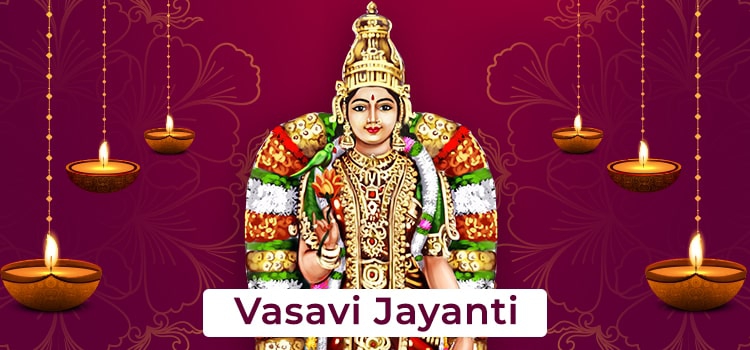Sri Kanyaka Parameshwari Jayanti (VASAVI JAYANTHI)
Goddess Vasavi Devi is believed to be a manifestation of Goddess Parvati. She is also known as Vasavi Kanyakaparameshwari Devi or Vasavi Matha. She took birth in the Vysya community, and history describes her as the first person who introduced the concept of Ahimsa or non-violence to the world. Vasavi became a martyr, along with her people, to prevent war and bloodshed. This Goddess is very popular in Andhra Pradesh and Karnataka. Vasavi Jayanthi marks the day she appeared on earth.
Birth of the Goddess
King Kusumasreshti and his wife, Kusumamba, had no children. Kusumasreshti was the king of the Vysyas (his capital was Penugonda, the(Kashi of the Arya Vysyas) during the 10th – 11th centuries. His kingdom was a part of Vengidesha, the ruler of which was Vishnuvardhana VII or Vimaladitya Maharaj.
The king and the queen used to worship Shiva in the form of Nagareshwara Swamy and Vishnu in the form of Janardhana Swamy regularly. As they had no children, their Kulaguru, Bhaskaracharya, advised them to perform a Putrakameshti yagna. After performing the Yagna, they received a divine fruit as Prasadam from the Gods through Yagneshwara. The queen ate the fruit and became pregnant soon after. During her pregnancy, the queen supposedly had unusual desires which hinted that she would have children who would fight for people’s welfare.
The queen delivered twins, a boy and a girl, on the 10th day of Vaishaka month. The royal couple named them Virupaksha and Vasavamba, respectively. Virupaksha showed leadership qualities even in childhood. Vasavamba was more interested in art, music, and architecture. She had a philosophical approach to life. Under Bhaskaracharya’s guidance, Virupaksha mastered the Vedas, fencing, horse riding, martial arts, etc., while Vasavamba learned the fine arts and philosophical subjects. When he attained adulthood, Virupaksha married the daughter of Aridhisresti of Aelur town, Rathnavati.

A Proposal
One day, King Vishnuvardhana came to Penugonda. He was on an expedition to expand his kingdom by overcoming his rivals. Kusumasresti gave him a red carpet welcome. His daughter, Vasavamba, performed a ceremonial Arathi for him. As soon as his eyes fell on the beautiful princess, Vishnuvardhana decided to make her his wife. The fact that he was older than her and was already married did not make a difference to him. Also, he was not a Vysya. Kusumasresti was in a dilemma as, according to the rules of his community, he could marry his daughter only to a Vysya man. But if he rejected the proposal, he would offend his king, and that would be calamitous for him and his people. Finally, he left it to his daughter. But she was not willing to get married; instead, she wanted to pursue a spiritual life.
Vasavi’s refusal to marry him enraged Vishnuvardhana. He declared war on Penugonda and sent a battalion to capture Vasavi. However, his army was defeated by the Vysyas. Kusumasresti then held a great conference in which the leaders of the 18 cities and the Gotrajas, or leaders of the 714 Gotras, took part. The aim was to discuss the future course of action.
A Split Verdict
While 612 gotrajas felt that the marriage would benefit the community and prevent war, the remaining 102 leaders felt that they should resist Vishnuvardhana. Bhaskaracharya also agreed with the latter view. His support emboldened Kusumasresti, and he, along with the 102 gotras, decided to put up a fight and defend their kingdom and princess.
On hearing this, Vasavi decided to express her views. She said that she did not want bloodshed and violence. She felt that non-violence and self-sacrifice were better options and that only people of great willpower and moral strength were capable of it. Kusumasresti was impressed by his daughter’s wisdom and decided to follow her directions.
Athma Balidhana
On Vasavi’s directions, the royal servants prepared 103 fire pits or Agni kunds in the sacred place of Brahmakunda on the banks of the Godavari river. For the people, it was like a festival day. Vasavi then asked the couples of the 102 Gotras whether they would jump into the holy fire along with her. All of them agreed as they felt that Vasavi was an incarnation of God. They also requested her to reveal her real nature (swarupa).
Vasavi then revealed her true self. It was even more radiant than the sun. She also declared that she was the incarnation of Adiparashakthi, who had come to earth during the Kali yuga to protect the dignity of women and Dharma. Her aim was to destroy Vishnu Vardhana and reveal to the world the magnanimity of the Vysya community. Like Sati, who entered the holy fire when she was insulted by her father, she would also jump into the holy fire. She also said that Kusumasresty was a great saint called Samadhi in his last birth and that he could attain salvation along with the people of 102 Gotras. For this reason, she wanted all of them to undergo Athma Balidhana. She also spoke to them about patriotism, honesty, social service, and tolerance.
Death of Vishnu Vardhana
The Goddess vanished as soon as she stopped speaking. All the people belonging to the 102 Gotras then jumped into the holy fire. Meanwhile, Vishnuvardhana saw bad omens as he marched toward Penugonda. On reaching the city and hearing of the events, he went into severe shock. He fell down, vomiting blood, and died.
Other Legends
Another story from Kanyakapurana says that Vasavi was the wife of Indra (Vasava is another name for Indra), who was born as the daughter of Kusumasreshti.
Vasavi’s Legacy
Vasavi Devi reminds us of virtues like compassion, self-sacrifice, love, non-violence, and character. She saves her devotees from temptations and protects family traditions.
There are 3 main festivals associated with her worship: (1) Vasavi Jayanti, or appearance day; (2) Vasavi Mata Atmarpana or the day she entered the sacred fire; and (3) Navaratri. Vasavi Devi is also the patron goddess of the Vysyas.
On Vasavi Jayanti, rituals like Ganesa Pooja, Durga homa, Abishekam, Archana with her 108 names, and Mahamangala arati are performed.
Vishnuvardhana’s son, Raja Raja Narendra, went to Penugonda and expressed his regrets for the incident. Virupaksha consoled him, saying that they should learn from Vasavi’s heroism and self-sacrifice. Thanks to her decision, war and bloodshed were averted for the benefit of the people. He also declared that henceforth the Vysya community would not fight or rule states but would perform services such as trade and agriculture and try to do good for others.
Virupaksha also visited many holy places like Kasi, Gaya, and others under the guidance of Baskaracharya and installed 101 Lingas for each gotra in Penugonda. Narendra also installed a statue of Vasavi to honor her. Since then, all Vysyas began worshipping her. They consider her to be the Vysyakula Devatha-Vasavi Kanyaka Parameswari. She became immortal, and the fame of Vysyas spread all over the world due to her.



















